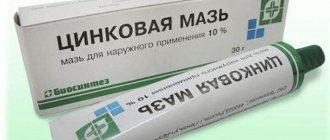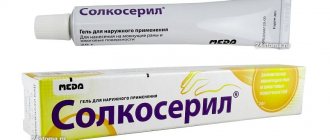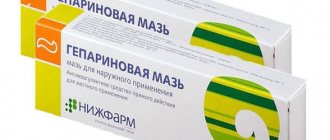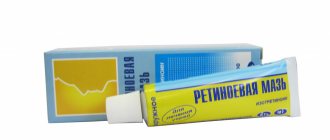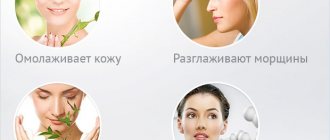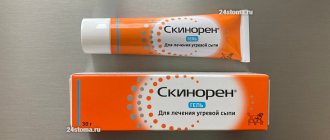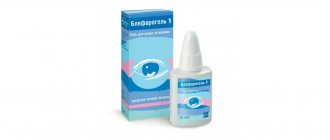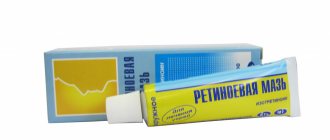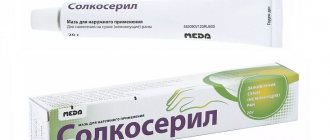Age-related deterioration in the appearance of the skin is an inevitable process that many women struggle with every day. Radevit ointment makes it possible to restore a healthy and toned appearance to your face without much effort. Despite the fact that the instructions recommend using the drug for the treatment of dermatological disorders, numerous consumer reviews indicate that its use allows you to quickly get rid of wrinkles.
Composition of the ointment
The components included in the product are completely natural and have a beneficial effect on the properties and condition of the skin. The main components of the drug are vitamins that improve the regeneration of the epidermis:
- retinol palmitate (vitamin A),
- alpha tocopherol (vitamin E),
- ergocalciferol (vitamin D2).
Excipients are responsible for the consistency and intensity of absorption of the drug:
- petrolatum,
- glycerol,
- cosmetic wax,
- alcohol,
- water,
- butylated hydroxytoluene (preservative).
The absence of dyes and fragrances means the ointment is relatively safe.
In pharmacology, there is a drug Radevit Active, almost identical in composition, where ergocalciferol is replaced by colecalciferol. This replacement of one of the components contributes to enhanced protection of the skin from photoaging.
special instructions
To achieve maximum results when applying ointment, it is important to follow a number of rules.
Among the special instructions for the use of Radevit:
- The simultaneous use of ointment and other drugs containing vitamins D, E, A and retinoids is prohibited. This will protect the body from the development of hypervitaminosis.
- The use of hormonal therapy reduces the effectiveness of Radevit application.
- If side effects occur, you can neutralize the effect of the cream using glucocorticosteroids or salicylates.
- To prevent the occurrence of hypervitaminosis, it is recommended to apply the cream to small areas of the skin.
- In case of severe exfoliation of the stratum corneum, the instructions for use recommend applying special dressings over the ointment. They protect the damaged area of the skin from oxygen penetration.
- Cracks, wounds and other damage must be pre-treated with an antiseptic.
Radevit is suitable for long-term use. The maximum duration of treatment can be 3 months.
Efficiency
Radevit is used in cosmetology as a nourishing and moisturizing agent for the face; it is especially popular among women over 30 years old. The effectiveness of the ointment is ensured by its fortified composition. Each component of the drug has its own effect on the epidermis, which in combination with other substances gives a visible result in the fight against wrinkles:
- Vitamin A – has an anti-inflammatory, rejuvenating and moisturizing effect on the skin. Promotes increased blood circulation, accelerates cellular renewal processes. Increases skin resistance to external influences, evens out facial tone and eliminates pigmentation.
- Vitamin E is a natural antioxidant that fights skin aging and has a lifting effect. Tocopherol regulates water balance, eliminates dryness and prevents photoaging. The presence of this component helps smooth the complexion, improve blood circulation in tissues and even prevents the development of cancer.
- Vitamin D2 - tones the skin, helps strengthen its immunity, fights inflammatory processes, heals damage and accelerates the regeneration of epidermal cells, stimulating the production of collagen.
- Glycerin is a well-known moisturizing component. With its help, the main active substances are actively absorbed into the inner layers of the epidermis. Glycerin serves as a conductor when applying the cream to the surface of the skin and nourishes flaky areas.
- Ethyl alcohol is a strong antiseptic and helps remove the fat layer from the surface of the skin. The drying effect helps to cope with problems such as pimples and acne.
Mechanism of action of the drug
Vitamin A has an anti-inflammatory and regenerating effect, prevents excessive growth of epithelial tissue of the skin and mucous membranes, improves cell nutrition, accelerates the healing of damage, regulates desquamation and redox processes. Most of the vitamin comes from food and is deposited in adipose tissue. Due to the pronounced medicinal properties of retinoids, systemic and local medications are produced on their basis.
Videstim ointment contains retinol palmitate, which binds to tissue cells using special receptors and directly affects them. As a result of use, the surface of the integument is leveled, inflammation and irritation are reduced. The active substance quickly penetrates into the deep layers, part of it is absorbed through the capillaries into the general bloodstream. On the surface of the skin, the ointment forms a protective film that protects inflamed areas from the effects of external negative factors.
The effect of the drug lasts for about 8–12 hours: pain and redness are reduced, the affected tissues gradually exfoliate, the development of hyperkeratosis and scar formation are prevented. Efficiency increases throughout the course of therapy. Penetrating into the body, retinol acts similarly to other forms of vitamin A: it takes part in metabolic processes, is deposited and metabolized in the liver.
Radevit in face masks
The use of Radevit ointment in cosmetology implies a wide range of its applications. Thus, the drug is included in face masks, which can be prepared at home. Before applying any of them, the skin must be cleaned of dirt and cosmetics and steamed.
Nourishing mask
Components:
- Radevit ointment - 2 cm,
- fresh egg yolk - 1 piece,
- natural fat sour cream - 1 tablespoon.
All components should be mixed thoroughly. Apply to facial skin, leave for 20-25 minutes, then rinse with warm water.
Anti-aging mask
For preparation you will need:
- Radevit - 3 cm,
- chamomile decoction - 1 tablespoon per 50 ml of boiling water,
- healing clay - 2 tablespoons.
After mixing the composition to the consistency of sour cream, spread it over the face and leave for 15-20 minutes, then rinse.
Toning mask
Ingredients:
- Radevit - 2 cm,
- egg yolk - 1 piece,
- crushed sea salt - ½ level teaspoon.
Grind the yolk with salt, add ointment and bring to a homogeneous mass. Apply a thin layer to the skin, avoiding the area around the eyes. Keep for no more than 3-5 minutes, after rinsing, repeat the process until the prepared composition is finished.
The effectiveness of Radevit® ointment containing retinol palmitate, ergocalciferol and tocopherol acetate on an emulsion basis was studied in 53 patients with skin diseases. The ointment was applied openly, under gauze or occlusive dressing. It has been established that the ointment has a pronounced softening, moisturizing, reparative effect, reduces skin inflammation, normalizes keratinization processes, restores skin elasticity, its turgor, reduces itching and pain. The ointment is highly effective for skin diseases and conditions accompanied by severe dryness, peeling, formation of cracks, erosions, abrasions, and allergic diseases. The ointment can be recommended to prevent premature skin aging. You should refrain from using it at the height of inflammatory reactions. The ointment is well tolerated and easy to use.
The purpose of the clinical study of the drug
was to clarify the indications for the use of Radevit® ointment in dermatological practice. We observed 53 patients who received inpatient or outpatient treatment at the clinic of skin and venereal diseases of the MMA named after. THEM. Sechenov. Among them are 26 men and 27 women, aged from 14 to 67 years.
The ointment was applied 2 times a day in a thin layer without rubbing for 3 weeks. When applying the ointment to the limbs, gauze bandages were used. In case of abundant layering of scales, occlusive dressings were used. Before starting therapy, all patients underwent a clinical and laboratory examination, which included a general and biochemical blood test, and a urine test.
During the study of the effectiveness of the drug, symptoms such as hyperemia, edema, weeping, infiltration, lichenification, papules, dry skin, peeling, cracks, itching, burning, and soreness were assessed. The dynamics of symptoms were assessed in points before treatment, and then after each week of observation on a 4-point scale: 1 - no symptom, 2 - mildly expressed, 3 - moderately expressed, 4 - severely expressed. The obtained results were subjected to statistical processing using the parametric Student test (t). Differences in symptoms compared with baseline signs were considered significant at P
Three groups of patients were observed:
- with disturbances in the keratinization process and age-related changes in the skin;
- with dermatitis and allergic dermatoses;
- with other diseases.
Disorders of the keratinization process, age-related skin changes
This group included patients with psoriasis - 12 people; patients with easily vulnerable skin exposed to damaging factors, age-related changes, xeroderma - 7 people and 1 patient with ordinary ichthyosis.
Among patients with psoriasis (8 men and 4 women aged 25 to 66 years), ordinary psoriasis was observed in 8 patients, exudative psoriasis in 2, and 2 patients suffered from palmoplantar psoriasis. Duration of the disease from 1 year to 18 years. All patients had a stationary stage of the process. The patients received traditional therapy with sedatives, desensitizing agents, injections of B vitamins, and physiotherapeutic procedures (Ultraviral irradiation, paraffin baths).
As can be seen from table.
1, when using Radevit® ointment during the first week, a significant flattening of the papules is observed. By the end of the second week, the brightness of the rashes, dry skin and peeling significantly decreased in the group as a whole. Plaque infiltration decreased noticeably only by the end of the 3rd week of drug use. When “Radevit” was prescribed under an occlusive dressing for palmoplantar psoriasis, accompanied by pronounced, sharply painful cracks, by the end of the second week, complete epithelization of the cracks, absence of pain, and a slight decrease in hyperemia were noted. However, infiltration in the foci did not change significantly. The best therapeutic effect was observed when treating lesions on the scalp with ointment (occlusive dressings for 1-1.5 hours). Clinical cure was achieved by 16-17 days of therapy. Table No. 1.
Dynamics of clinical symptoms in patients with psoriasis during local treatment with Radevit® ointment in points (M ± m).
| Symptoms | Before treatment | First week | Second week | Third week |
| Erythema | 3,0 ± 0,24 | 2,43 ± 0,22 | 2,0 ± 0,0* | 1,71 ± 0,20 |
| Papules | 3,3 ± 0,16 | 2,60 ± 0,23* | 2,30 ± 0,27 | 2,10 ± 0,33 |
| Infiltration | 3,0 ± 0,20 | 2,63 ± 0,20 | 2,50 ± 0,20 | 2,13 ± 0,32* |
| Dryness | 3,25 ± 0,31 | 2,63 ± 0,40 | 2,0 ± 0,33* | 1,38 ± 0,22 |
| Peeling | 3,5 ± 0,29 | 2,63 ± 0,28 | 1,75 ± 0,27* | 1,50 ± 0,20 |
In two patients, when using the drug for one week, negative dynamics were noted. Thus, patient M., 48 years old, with diffuse exudative lesions of the scalp, noted an increase in the phenomena of exudation in the form of increased formation of large-plate scales-crusts soaked in serous fluid. The second patient, who used Radevit® on the palms and soles, noted increased itching, hyperemia and pain in the cracks.
Dermatitis and allergic dermatoses
In this group, 19 patients with atopic dermatitis, 8 patients suffering from eczema, and 1 patient with bullous photodermatitis received treatment with Radevit® ointment.
Among the patients with atopic dermatitis there were 8 women and 11 men aged from 14 to 38 years. Clinical diagnosis was established based on the diagnostic criteria proposed by Hanifin and Rajka (1980). The group included patients with both localized skin lesions (hyperemia, lichenification in the elbow and popliteal folds, on the skin of the face and neck), and with widespread small-papular rashes with a tendency to erythroderma. Patients were bothered by a sharp, sometimes painful itching, and a feeling of tightness of the skin. At the clinic, patients received traditional therapy, including antihistamines, desensitizing and psychotropic drugs, vitamins C and B, physiotherapeutic procedures (UV irradiation, D'Arsonval currents, IHF therapy, paraffin baths, etc.), topical indifferent creams and ointments.
Table 2 shows that such characteristics as erythema, papules, infiltration, dry skin, peeling and itching significantly change within a week after the start of smearing the lesions with “Radevit”.
Signs of lichenification significantly decreased by the end of the second week. In this case, almost complete epithelization of the cracks is observed. However, moderate lichenification in the lesions persists even after three weeks of use of the ointment. All patients noted a decrease in the feeling of skin tightness and indicated an increase in its elasticity in the affected areas. From our point of view, the drug should not be prescribed when the severity of the process is pronounced, and especially on the skin of the face. Thus, under our observation was patient M., 17 years old, with facial skin lesions in the form of bright hyperemia, swelling, moderate infiltration, abundant exfoliation and hemorrhagic crusts. When using “Radevit” for a week, the feeling of skin tightness decreased somewhat, but all other symptoms remained, and the hyperemia increased somewhat. Table No. 2.
Dynamics of clinical symptoms in patients with atopic dermatitis during local treatment with Radevit® ointment in points (M ± m).
| Symptoms | Before treatment | First week | Second week | Third week |
| Erythema | 2,94 ± 0,17 | 2,11 ± 0,17* | 1,65 ± 0,12 | 1,35 ± 0,12 |
| Infiltration | 3,0 ± 0,20 | 2,24 ± 0,19* | 1,71 ± 0,18 | 1,59 ± 0,17 |
| Lichenification | 3,0 ± 0,22 | 2,94 ± 0,22 | 1,94 ± 0,17* | 1,82 ± 0,16 |
| Papules | 2,77 ± 0,23 | 2,06 ± 0,23* | 1,53 ± 0,18 | 1,29 ± 0,19 |
| Dryness | 3,35 ± 0,18 | 2,41 ± 0,20* | 1,88 ± 0,12 | 1,53 ± 0,13 |
| Peeling | 2,82 ± 0,16 | 2,06 ± 0,14* | 1,65 ± 0,12 | 1,12 ± 0,11 |
| Cracks | 2,0 ± 0,31 | 1,35 ± 0,12 | 1,1 ± 0,12* | 1,0 ± 0,0 |
| Itching | 3,06 ± 0,32 | 2,12 ± 0,18* | 1,65 ± 0,19 | 1,29 ± 0,12 |
We observed 4 women and 4 men aged from 20 to 56 years with different types of eczema, in the subacute and chronic stages.
The process was localized more often on the hands and feet and was represented by pronounced skin infiltration, hyperemia, with a stagnant tint, abundant small-papular rashes, deep painful cracks, layers of fine-lamellar scales, and areas of hyperkeratosis on the palms and soles. Patients complained of a feeling of skin tightness and moderate itching. At the same time, traditional therapy was carried out with antihistamines and sedatives, B vitamins, diuretics and laxatives, local baths with sea salt, lotions, indifferent creams and pastes. Table No. 3.
Dynamics of clinical symptoms in patients with eczema during local treatment with Radevit® ointment in points (M ± m).
| Symptoms | Before treatment | First week | Second week | Third week |
| Erythema | 2,44 ± 0,26 | 2,11 ± 0,21 | 1,44 ± 0,19* | 1,33 ± 0,18 |
| Infiltration | 3,33 ± 0,31 | 2,66 ± 0,31 | 2,11 ± 0,20* | 1,88 ± 0,33 |
| Papules | 2,22 ± 0,33 | 1,88 ± 0,31 | 1,66 ± 0,32 | 1,44 ± 0,23* |
| Dryness | 3,44 ± 0,36 | 2,44 ± 0,26* | 1,77 ± 0,16 | 1,44 ± 0,19 |
| Peeling | 3,44 ± 0,36 | 2,44 ± 0,31 | 1,44 ± 0,26* | 1,33 ± 0,18 |
| Cracks | 2,66 ± 0,39 | 2,0 ± 0,25 | 1,1 ± 0,12* | 1,0 ± 0,0 |
| Itching | 2,22 ± 0,23 | 1,66 ± 0,25 | 1,66 ± 0,23 | 1,33 ± 0,18* |
When analyzing the results of local therapy of patients with eczema with Radevit® ointment for the whole group, it was found that during the first week only dry skin significantly decreased, by the end of the second week there was a significant weakening in the brightness of the color of the lesions, a decrease in infiltration and peeling, and epithelization of cracks. Papules and itching underwent noticeable regression only at the end of the drug trial, that is, at the end of the third week. Patient P., 56 years old, had mild weeping, which resolved by the 12-13th day of using the ointment.
It seems inappropriate to prescribe the drug in the acute stage of the process. Thus, we noted negative dynamics in a 44-year-old patient who was admitted with a sharp exacerbation of eczema of the hands. Radevit® was prescribed immediately after the swelling decreased and the appearance of fresh blisters stopped. On the third day of use, the appearance of abundant, small, bright pink, conical papules was again noted on the back of the hands. Thus, in such cases, the use of ointment should be considered premature.
The result of prescribing Radevit® ointment for bullous photodermatitis that developed after an overdose of ultraviolet radiation in a patient with psoriasis is interesting. On the third day of using the ointment, swelling and pain completely disappeared; by days 8-10, hyperemia significantly decreased, and active epithelization of erosions was noted. By 19-20 days, complete regression of the rash was achieved.
Other diseases
This group included 5 patients. A positive effect was noted in the treatment of a 33-year-old patient with ulcerative pyoderma of the leg. The duration of the disease was one month. Radevit® ointment was applied under a bandage twice a day after cleaning ulcers and lotions with furacillin solution. Within a week, the hyperemia around the ulcers was completely resolved, the pain syndrome disappeared, and by the end of the second week, complete scarring was recorded.
The ointment also had a beneficial effect on widespread lichen sclerosus in a 65-year-old woman. After using “Radevit,” the elasticity of the lesions noticeably improved, and unpleasant subjective sensations disappeared.
When trying to use the ointment in two patients with alopecia areata and one with lichen planus, no clear dynamics were observed for 3 weeks.
Conclusion
During testing it was established that Radevit® ointment:
- has a pronounced softening, moisturizing, reparative effect;
- reduces skin inflammation;
- normalizes keratinization processes;
- restores skin elasticity and turgor;
- reduces itching and pain.
It should be noted that the drug is highly effective in the complex treatment of skin diseases and conditions accompanied by severe dryness, peeling, the formation of cracks, erosions, abrasions (ichthyosis, eczema, age-related skin changes), inflammatory, including allergic, diseases (eczema, atopic dermatitis, dermatitis, psoriasis). The ointment should be recommended for the prevention of premature skin aging.
From our point of view, one should refrain from using the ointment at the height of acute inflammatory reactions, and prescribe it in the subacute and chronic stages of the process, during the period of predominance of dryness and peeling.
It should be noted that Radevit® ointment is well tolerated. Laboratory monitoring during treatment did not reveal any deviations in clinical and biochemical blood tests or urine tests.
O.L. Ivanov, M.A. Samgin, O.V. Grabovskaya
Seal
Contraindications
Despite the fact that the product is intended for external use only, it has a number of contraindications:
- An increased concentration in the body of one or more of the vitamins that make up the ointment (A, E or D) can become a serious obstacle to its use: an allergic reaction is possible. Radevit is contraindicated for people who receive these substances from other cosmetics or take fortified preparations.
- The ointment is contraindicated for people who are allergic to any of its components.
- Not recommended for pregnant and lactating women.
Radevit should be used after consultation with a dermatologist and testing for allergic reactions.
Indications for use
Radevit, an anti-wrinkle ointment, reviews of cosmetologists about which speak of a visible rejuvenation effect with regular use, are prescribed for a number of medical indications. They include pathological abnormalities of the skin, the course of the inflammatory process and the presence of damaged cells.
Situations when the use of the drug is necessary:
- Ichthyosis. A hereditary disease, the main symptom of which is a violation of the formation of the stratum corneum. In case of pathology, the ointment is used as a component of complex treatment.
- Seborrheic dermatitis. It is characterized by increased production of fat by the sebaceous glands.
- Erosion and cracks on the surface of various natures.
- Chemical and thermal burns ;
- Damage caused by radiation.
- Trophic ulcers of a non-infected nature. Their appearance is associated with insufficient tissue nutrition.
- Allergic dermatitis during the period of weakening the inflammatory process and improving the appearance of the skin.
- Psoriasis. It is a chronic disease. It occurs under the influence of constant stress, taking medications, endocrine pathologies and bad habits.
- Eczema. A non-infectious disease that has a chronic form. Occurs under the influence of various factors that cause damage.
- Atopic dermatitis. Long-term inflammation of the skin, which is recurrent in nature. Pathology develops under the influence of genetic abnormalities occurring in tissues.
- Neurodermatitis. It manifests itself as a rash, skin lichenification and the formation of papules. The affected skin is very itchy. Radevit is effective against such itching.
- Diffuse neurodermatitis. Associated with deviations in the innervation of the epidermis.
The drug is used for prophylactic purposes against the occurrence of various inflammatory processes and allergic manifestations on the skin. Radevit in the form of an ointment or cream is also suitable for preventing the onset of signs of aging.
Dermatologists and cosmetologists recommend Radevit to their patients to improve skin condition.
Regular use helps prolong the youth of the skin. The moisturizing and restorative properties of the product allow it to be used to solve cosmetic problems.
Price in pharmacies in Moscow, St. Petersburg, regions
The cost of a medicine depends on many parameters. It can be influenced by the pharmacy chain and its location, the pharmaceutical company and the country of manufacture. Radevit is considered an affordable drug, its price is relatively low. You can purchase the ointment both in city pharmacies and through the online store.
The approximate cost in different cities is presented in the table.
| City | Price for 35 g, rub. |
| Moscow | from 336 |
| Saint Petersburg | from 329 |
| Ekaterinburg | from 313 |
| Ryazan | from 329 |
| Vladivostok | from 345 |
Analogs
Radevit, an anti-wrinkle ointment, reviews of which from cosmetologists are in most cases good, has a unique structure. There are no drugs that are the same. Analogues are only similar in their effect.
Among analogues:
- Linin. The components of the composition are similar to Radevit. Suitable for treating wounds and various surface damage. Accelerates the restoration of tissue integrity and relieves severe itching. The cost for 30 g of the drug starts from 60 rubles.
- Linetol. Metabolic ointment, the action of which is aimed at normalizing the metabolic processes that occur in the layers of the dermis. Available in solution form. For one 100 ml bottle you will have to pay approximately 138 rubles.
- Colocyl. The product has an antiseptic and restorative effect. Sold in the form of a sponge, the cost of which varies from 90 to 150 rubles. Apply to damaged skin.
- Carl. The drug has a wound healing and reparative effect. The sponge is soaked in ointment. Suitable for people who suffer from frequent allergies. It does not cause negative reactions in the body. It is used for radiation diseases of the mucous membranes and skin.
Each drug has its own composition, contraindications and side effects. Therefore, it is not recommended to change the drug yourself to a similar medicine. Before doing this, you should consult with your doctor. He will advise which ointment is best as a replacement.
